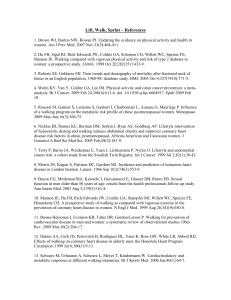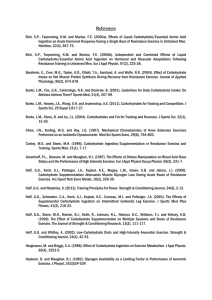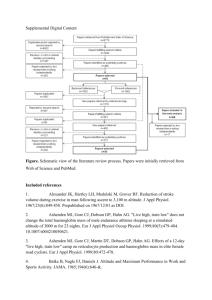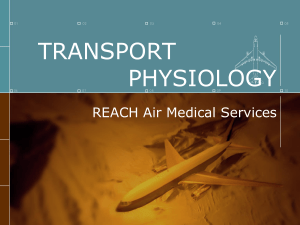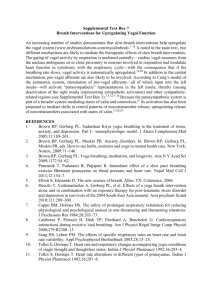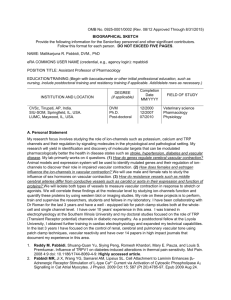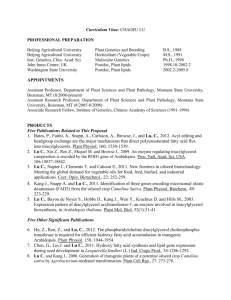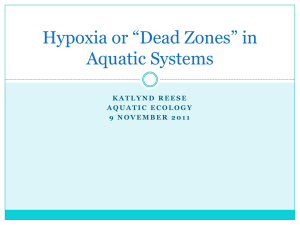References included in Meta-Analysis 1. Adams WC, Bernauer EM
advertisement
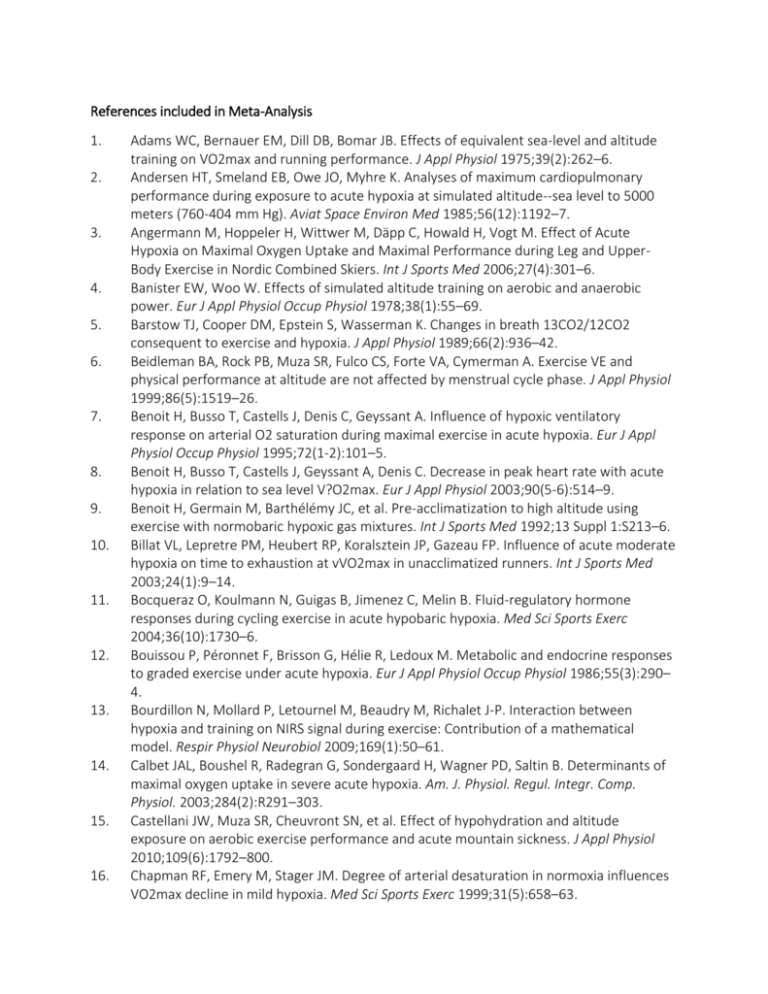
References included in Meta-Analysis 1. 2. 3. 4. 5. 6. 7. 8. 9. 10. 11. 12. 13. 14. 15. 16. Adams WC, Bernauer EM, Dill DB, Bomar JB. Effects of equivalent sea-level and altitude training on VO2max and running performance. J Appl Physiol 1975;39(2):262–6. Andersen HT, Smeland EB, Owe JO, Myhre K. Analyses of maximum cardiopulmonary performance during exposure to acute hypoxia at simulated altitude--sea level to 5000 meters (760-404 mm Hg). Aviat Space Environ Med 1985;56(12):1192–7. Angermann M, Hoppeler H, Wittwer M, Däpp C, Howald H, Vogt M. Effect of Acute Hypoxia on Maximal Oxygen Uptake and Maximal Performance during Leg and UpperBody Exercise in Nordic Combined Skiers. Int J Sports Med 2006;27(4):301–6. Banister EW, Woo W. Effects of simulated altitude training on aerobic and anaerobic power. Eur J Appl Physiol Occup Physiol 1978;38(1):55–69. Barstow TJ, Cooper DM, Epstein S, Wasserman K. Changes in breath 13CO2/12CO2 consequent to exercise and hypoxia. J Appl Physiol 1989;66(2):936–42. Beidleman BA, Rock PB, Muza SR, Fulco CS, Forte VA, Cymerman A. Exercise VE and physical performance at altitude are not affected by menstrual cycle phase. J Appl Physiol 1999;86(5):1519–26. Benoit H, Busso T, Castells J, Denis C, Geyssant A. Influence of hypoxic ventilatory response on arterial O2 saturation during maximal exercise in acute hypoxia. Eur J Appl Physiol Occup Physiol 1995;72(1-2):101–5. Benoit H, Busso T, Castells J, Geyssant A, Denis C. Decrease in peak heart rate with acute hypoxia in relation to sea level V?O2max. Eur J Appl Physiol 2003;90(5-6):514–9. Benoit H, Germain M, Barthélémy JC, et al. Pre-acclimatization to high altitude using exercise with normobaric hypoxic gas mixtures. Int J Sports Med 1992;13 Suppl 1:S213–6. Billat VL, Lepretre PM, Heubert RP, Koralsztein JP, Gazeau FP. Influence of acute moderate hypoxia on time to exhaustion at vVO2max in unacclimatized runners. Int J Sports Med 2003;24(1):9–14. Bocqueraz O, Koulmann N, Guigas B, Jimenez C, Melin B. Fluid-regulatory hormone responses during cycling exercise in acute hypobaric hypoxia. Med Sci Sports Exerc 2004;36(10):1730–6. Bouissou P, Péronnet F, Brisson G, Hélie R, Ledoux M. Metabolic and endocrine responses to graded exercise under acute hypoxia. Eur J Appl Physiol Occup Physiol 1986;55(3):290– 4. Bourdillon N, Mollard P, Letournel M, Beaudry M, Richalet J-P. Interaction between hypoxia and training on NIRS signal during exercise: Contribution of a mathematical model. Respir Physiol Neurobiol 2009;169(1):50–61. Calbet JAL, Boushel R, Radegran G, Sondergaard H, Wagner PD, Saltin B. Determinants of maximal oxygen uptake in severe acute hypoxia. Am. J. Physiol. Regul. Integr. Comp. Physiol. 2003;284(2):R291–303. Castellani JW, Muza SR, Cheuvront SN, et al. Effect of hypohydration and altitude exposure on aerobic exercise performance and acute mountain sickness. J Appl Physiol 2010;109(6):1792–800. Chapman RF, Emery M, Stager JM. Degree of arterial desaturation in normoxia influences VO2max decline in mild hypoxia. Med Sci Sports Exerc 1999;31(5):658–63. 17. 18. 19. 20. 21. 22. 23. 24. 25. 26. 27. 28. 29. 30. 31. 32. 33. 34. 35. Clark SA, Bourdon PC, Schmidt W, et al. The effect of acute simulated moderate altitude on power, performance and pacing strategies in well-trained cyclists. Eur J Appl Physiol 2007;102(1):45–55. Cymerman A, Pandolf KB, Young AJ, Maher JT. Energy expenditure during load carriage at high altitude. J Appl Physiol 1981;51(1):14–8. Desplanches D, Hoppeler H, Linossier MT, et al. Effects of training in normoxia and normobaric hypoxia on human muscle ultrastructure. Pflugers Arch - Eur J Physiol 1993;425(3-4):263–7. Drinkwater BL, Folinsbee LJ, Bedi JF, Plowman SA, Loucks AB, Horvath SM. Response of women mountaineers to maximal exercise during hypoxia. Aviat Space Environ Med 1979;50(7):657–62. Esposito F, Ferretti G. The effects of breathing He–O2 mixtures on maximal oxygen consumption in normoxic and hypoxic men. J Physiol 1997;503(1):215–21. Esposito F, Limonta E, Alberti G, Veicsteinas A, Ferretti G. Effect of respiratory muscle training on maximum aerobic power in normoxia and hypoxia. Respir Physiol Neurobiol 2010;170(3):268–72. Fagraeus L, Karlsson J, Linnarsson D, Saltin B. Oxygen uptake during maximal work at lowered and raised ambient air pressures. Acta Physiol. Scand. 1973;87(3):411–21. Faoro V, Lamotte M, Deboeck G, et al. Effects of sildenafil on exercise capacity in hypoxic normal subjects. High Alt. Med. Biol. 2007;8(2):155–63. Faoro V. Bosentan Decreases Pulmonary Vascular Resistance and Improves Exercise Capacity in Acute Hypoxia. Chest 2009;135(5):1215. Ferretti G, Moia C, Thomet JM, Kayser B. The decrease of maximal oxygen consumption during hypoxia in man: a mirror image of the oxygen equilibrium curve. J Physiol 1997;498 ( Pt 1):231–7. Friedmann B, BAUER T, Menold E, Bartsch P. Exercise with the Intensity of the Individual Anaerobic Threshold in Acute Hypoxia. Med Sci Sports Exerc 2004;36(10):1737–42. Friedmann B, Frese F, Menold E, Bärtsch P. Individual Variation in the Reduction of Heart Rate and Performance at Lactate Thresholds in Acute Normobaric Hypoxia. Int J Sports Med 2005;26(7):531–6. Fukuda T, Maegawa T, Matsumoto A, et al. Effects of acute hypoxia at moderate altitude on stroke volume and cardiac output during exercise. Int Heart J 2010;51(3):170–5. Fulco CS, Muza SR, Beidleman B, et al. Exercise performance of sea-level residents at 4300 m after 6 days at 2200 m. Aviat Space Environ Med 2009;80(11):955–61. Fulco CS, Rock PB, Trad L, Forte V, Cymerman A. Maximal cardiorespiratory responses to one- and two-legged cycling during acute and long-term exposure to 4300 meters altitude. Eur J Appl Physiol Occup Physiol 1988;57(6):761–6. Gavin TP, Derchak PA, Stager JM. Ventilation's role in the decline in VO2max and SaO2 in acute hypoxic exercise. Med Sci Sports Exerc 1998;30(2):195–9. Gore CJ, Hahn AG, Scroop GC, et al. Increased arterial desaturation in trained cyclists during maximal exercise at 580 m altitude. J Appl Physiol 1996;80(6):2204–10. Gore CJ, Little SC, Hahn AG, et al. Reduced performance of male and female athletes at 580 m altitude. Eur J Appl Physiol Occup Physiol 1997;75(2):136–43. Greenleaf JE, Greenleaf J, Card DH, Saltin B. Exercise-temperature regulation in man 36. 37. 38. 39. 40. 41. 42. 43. 44. 45. 46. 47. 48. 49. 50. 51. 52. 53. during acute exposure to simulated altitude. J Appl Physiol 1969;26(3):290–6. Hartley LH, Vogel JA, Landowne M. Central, femoral, and brachial circulation during exercise in hypoxia. J Appl Physiol 1973;34(1):87–90. Hogan MC, Cox RH, Welch HG. Lactate accumulation during incremental exercise with varied inspired oxygen fractions. J Appl Physiol 1983;55(4):1134–40. Hopkins SR, Bogaard HJ, Niizeki K, Yamaya Y, Ziegler MG, Wagner PD. Beta-adrenergic or parasympathetic inhibition, heart rate and cardiac output during normoxic and acute hypoxic exercise in humans. J Physiol 2003;550(Pt 2):605–16. Horstman D, Weiskopf R, Jackson RE. Work capacity during 3-wk sojourn at 4,300 m: effects of relative polycythemia. J Appl Physiol 1980;49(2):311–8. Horstman DH, Weiskopf R, Robinson S. The nature of the perception of effort at sea level and high altitude. Med Sci Sports 1979;11(2):150–4. Hughes RL, Clode M, Edwards RH, Goodwin TJ, Jones NL. Effect of inspired O2 on cardiopulmonary and metabolic responses to exercise in man. J Appl Physiol 1968;24(3):336–47. Kjaergaard J, Snyder EM, Hassager C, et al. Right ventricular function with hypoxic exercise: effects of sildenafil. Eur J Appl Physiol 2007;102(1):87–95. Knuttgen HG, Saltin B. Oxygen uptake, muscle high-energy phosphates, and lactate in exercise under acute hypoxic conditions in man. Acta Physiol. Scand. 1973;87(3):368–76. Koistinen P, Takala T, Martikkala V, Leppäluoto J. Aerobic fitness influences the response of maximal oxygen uptake and lactate threshold in acute hypobaric hypoxia. Int J Sports Med 1995;16(2):78–81. Lawler J, Powers SK, Thompson D. Linear relationship between VO2max and VO2max decrement during exposure to acute hypoxia. J Appl Physiol 1988;64(4):1486–92. Levine BD, Friedman DB, Engfred K, et al. The effect of normoxic or hypobaric hypoxic endurance training on the hypoxic ventilatory response. Med Sci Sports Exerc 1992;24(7):769–75. Levitan BM, Bungo MW. Measurement of cardiopulmonary performance during acute exposure to a 2440-m equivalent atmosphere. Aviat Space Environ Med 1982;53(7):639– 42. Linnarsson D, Karlsson J, Fagraeus L, Saltin B. Muscle metabolites and oxygen deficit with exercise in hypoxia and hyperoxia. J Appl Physiol 1974;36(4):399–402. Lundby C. Pulmonary gas exchange at maximal exercise in Danish lowlanders during 8 wk of acclimatization to 4,100 m and in high-altitude Aymara natives. Am J Physiol Regul Integr Comp Physiol 2004;287(5):R1202–8. Martin D, O'Kroy J. Effects of acute hypoxia on the VO 2max of trained and untrained subjects. J Sports Sci 1993;11(1):37–42. Masschelein E, Van Thienen R, Thomis M, Hespel P. High Twin Resemblance for Sensitivity to Hypoxia. Med Sci Sports Exerc 2014;:1. McLellan T, Jacobs I, Lewis W. Acute altitude exposure and altered acid-base states. I. Effects on the exercise ventilation and blood lactate responses. Eur J Appl Physiol Occup Physiol 1988;57(4):435–44. Mollard P, Woorons X, Letournel M, et al. Determinants of maximal oxygen uptake in moderate acute hypoxia in endurance athletes. Eur J Appl Physiol 2007;100(6):663–73. 54. 55. 56. 57. 58. 59. 60. 61. 62. 63. 64. 65. 66. 67. 68. 69. 70. 71. Murphy PC, Cuervo LA, Hughson RL. A study of cardiorespiratory dynamics with step and ramp exercise tests in normoxia and hypoxia. Cardiovasc. Res. 1989;23(10):825–32. Naeije R, Huez S, Lamotte M, et al. Pulmonary artery pressure limits exercise capacity at high altitude. European Respiratory Journal 2010;36(5):1049–55. Noordhof DA, Schoots T, Hoekert DH, de Koning JJ. Is gross efficiency lower at acute simulated altitude than at sea level? Int J Sports Physiol Perform 2013;8(3):319–22. Ogawa T, Calbet JAL, Honda Y, Fujii N, Nishiyasu T. The effects of breathing a helium– oxygen gas mixture on maximal pulmonary ventilation and maximal oxygen consumption during exercise in acute moderate hypobaric hypoxia. Eur J Appl Physiol 2010;110(4):853– 61. Ozcelik O, Kelestimur H. Effects of acute hypoxia on the determination of anaerobic threshold using the heart rate-work rate relationships during incremental exercise tests. Physiol Res 2004;53(1):45–51. Paterson DJ, Pinnington H, Pearce AR, Morton AR. Maximal exercise cardiorespiratory responses of men and women during acute exposure to hypoxia. Aviat Space Environ Med 1987;58(3):243–7. Peltonen JE, Rantamäki J, Niittymäki SP, Sweins K, Viitasalo JT, Rusko HK. Effects of oxygen fraction in inspired air on rowing performance. Med Sci Sports Exerc 1995;27(4):573–9. Peltonen JE, Tikkanen HO, Rusko HK. Cardiorespiratory responses to exercise in acute hypoxia, hyperoxia and normoxia. Eur J Appl Physiol 2001;85(1-2):82–8. Ponsot E, Dufour SP, Doutreleau S, et al. Impairment of maximal aerobic power with moderate hypoxia in endurance athletes: do skeletal muscle mitochondria play a role? Am J Physiol Regul Integr Comp Physiol 2010;298(3):R558–66. Prommer N, Heinicke K, Viola T, Cajigal J, Behn C, Schmidt WFJ. Long-Term Intermittent Hypoxia Increases O 2-Transport Capacity but Not V O 2max. High Alt. Med. Biol. 2007;8(3):225–35. Puype J, van Proeyen K, Raymackers J-M, Deldicque L, Hespel P. Sprint Interval Training in Hypoxia Stimulates Glycolytic Enzyme Activity. Med Sci Sports Exerc 2013;45(11):2166–74. Reeves JT, Grover RF, Cohn JE. Regulation of ventilation during exercise at 10,200 ft in athletes born at low altitude. J Appl Physiol 1967;22(3):546–54. Robergs RA, Quintana R, Parker DL, Frankel CC. Multiple variables explain the variability in the decrement in VO2max during acute hypobaric hypoxia. Med Sci Sports Exerc 1998;30(6):869–79. Roberts AD, Daley PJ, Martin DT, Hahn A, Gore CJ, Spence R. Sea level VO2max fails to predict VO2max and performance at 1800m altitude. Med Sci Sports Exerc 1998;30(5):Supplement 111. Robertson RJ, Gilcher R, Metz KF, et al. Effect of induced erythrocythemia on hypoxia tolerance during physical exercise. J Appl Physiol 1982;53(2):490–5. Roca J, Agusti AG, Alonso A, et al. Effects of training on muscle O2 transport at VO2max. J Appl Physiol 1992;73(3):1067–76. Roels B, Thomas C, Bentley DJ, Mercier J, Hayot M, Millet G. Effects of intermittent hypoxic training on amino and fatty acid oxidative combustion in human permeabilized muscle fibers. J Appl Physiol 2007;102(1):79–86. Shephard RJ, Bouhlel E, Vandewalle H, Monod H. Peak oxygen intake and hypoxia: 72. 73. 74. 75. 76. 77. 78. 79. 80. influence of physical fitness. Int J Sports Med 1988;9(4):279–83. Springer C, Barstow TJ, Wasserman K, Cooper DM. Oxygen uptake and heart rate responses during hypoxic exercise in children and adults. Med Sci Sports Exerc 1991;23(1):71–9. Squires RW, Buskirk ER. Aerobic capacity during acute exposure to simulated altitude, 914 to 2286 meters. Med Sci Sports Exerc 1982;14(1):36–40. Stenberg J, Ekblom B, Messin R. Hemodynamic response to work at simulated altitude, 4,000 m. J Appl Physiol 1966;21(5):1589–94. Subudhi AW, Jacobs KA, Hagobian TA, et al. Changes in ventilatory threshold at high altitude: effect of antioxidants. Med Sci Sports Exerc 2006;38(8):1425–31. Terrados N, Mizuno M, Andersen H. Reduction in maximal oxygen uptake at low altitudes; role of training status and lung function. Clin Physiol 1985;5 Suppl 3:75–9. Wagner JA, Miles DS, Horvath SM, Reyburn JA. Maximal work capacity of women during acute hypoxia. J Appl Physiol 1979;47(6):1223–7. Wehrlin JP, Hallén J. Linear decrease in .VO2max and performance with increasing altitude in endurance athletes. Eur J Appl Physiol 2006;96(4):404–12. Woorons X, Mollard P, Lamberto C, Letournel M, Richalet J-P. Effect of acute hypoxia on maximal exercise in trained and sedentary women. Med Sci Sports Exerc 2005;37(1):147– 54. Young AJ, Evans WJ, Cymerman A, Pandolf KB, Knapik JJ, Maher JT. Sparing effect of chronic high-altitude exposure on muscle glycogen utilization. J Appl Physiol 1982;52(4):857–62.
